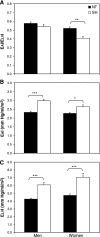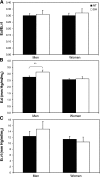The sex-specific impact of systolic hypertension and systolic blood pressure on arterial-ventricular coupling at rest and during exercise
- PMID: 18456731
- PMCID: PMC2494772
- DOI: 10.1152/ajpheart.01179.2007
The sex-specific impact of systolic hypertension and systolic blood pressure on arterial-ventricular coupling at rest and during exercise
Abstract
In healthy subjects the arterial system and the left ventricle (LV) are tightly coupled at rest to optimize cardiac performance. Systolic hypertension (SH) is a major risk factor for heart failure and is associated with structural and functional alterations in the arteries and the LV. The effects of SH and resting systolic blood pressure (SBP) on arterial-ventricular coupling (E(a)I/E(LV)I) at rest, at peak exercise, and during recovery are not well described. We noninvasively characterized E(a)I/E(LV)I as end-systolic volume index/stroke volume index in subjects who were normotensive (NT, n = 203) or had SH (brachial SBP > or =140 mmHg, n = 79). Cardiac volumes were measured at rest and throughout exhaustive upright cycle exercise with gated blood pool scans. E(a)I/E(LV)I reserve was calculated by subtracting peak from resting E(a)I/E(LV)I. At rest, E(a)I/E(LV)I did not differ between SH and NT men but was 23% (P = 0.001) lower in SH vs. NT women. E(a)I/E(LV)I did not differ between SH and NT men or women at peak exercise or during recovery. Nevertheless, E(a)I/E(LV)I reserve was 61% (P < 0.001) lower in SH vs. NT women. Similarly, resting SBP (as a continuous variable) was not associated with E(a)I/E(LV)I in men (beta = -0.12, P = 0.17) but was inversely associated with E(a)I/E(LV)I in women (beta = -0.47, P < 0.001). SH and a higher resting brachial SBP are associated with a lower E(a)I/E(LV)I at rest in women but not in men, and SH women have an attenuated E(a)I/E(LV)I reserve. Whether a smaller E(a)I/E(LV)I reserve leads to functional limitations warrants further examination.
Figures




References
-
- Ahlund C, Pettersson K, Lind L. Pulse wave analysis on fingertip arterial pressure: effects of age, gender and stressors on reflected waves and their relation to brachial and femoral artery blood flow. Clin Physiol Funct Imaging 28: 86–95, 2008. - PubMed
-
- Asanoi H, Sasayama S, Kameyama T. Ventriculoarterial coupling in normal and failing heart in humans. Circ Res 65: 483–493, 1989. - PubMed
-
- Berry KL, Cameron JD, Dart AM, Dewar EM, Gatzka CD, Jennings GL, Liang YL, Reid CM, Kingwell BA. Large-artery stiffness contributes to the greater prevalence of systolic hypertension in elderly women. J Am Geriatr Soc 52: 368–373, 2004. - PubMed
-
- Bing OH, Conrad CH, Boluyt MO, Robinson KG, Brooks WW. Studies of prevention, treatment and mechanisms of heart failure in the aging spontaneously hypertensive rat. Heart Fail Rev 7: 71–88, 2002. - PubMed
-
- Borlaug BA, Melenovsky V, Russell SD, Kessler K, Pacak K, Becker LC, Kass DA. Impaired chronotropic and vasodilator reserves limit exercise capacity in patients with heart failure and a preserved ejection fraction. Circulation 114: 2138–2147, 2006. - PubMed
Publication types
MeSH terms
Grants and funding
LinkOut - more resources
Full Text Sources
Medical
Research Materials

